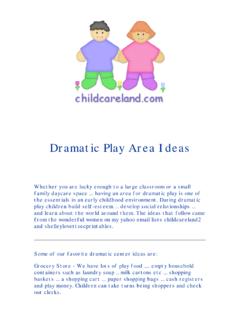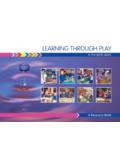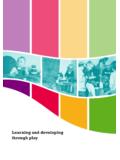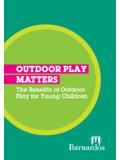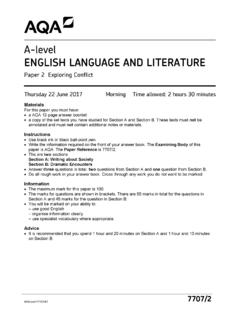Transcription of In Play: An Important Tool for - Commerce …
1 In ThIs IssueFEATURE ARTICLE: play : An Important tool for Cognitive Developmentpage 1 CLASSROOM HINTS:Planning Assists Children s Executive Function page 9 SPECIAL EDUCATION: play An Intentional Intervention!page 12 TRAINER-TO-TRAINER:Supporting Executive Function in Children s Playpage 14 NEWS BRIEFS page 16 ASK USpage 16 VOLUME 24, NO. 3 play : An Important tool for Cognitive DevelopmentTake a look at the play of Gabrielle, a three-year-old who has a plan to play with magnetic tiles:At planning time, Gabrielle says, I m going to play with the doggies and Magnatiles in the toy area.
2 I m making a tall elevator. At work time, Gabrielle builds with the magnetic tiles while playing with the small toy dogs, as she planned. She stacks the tiles on top of one another in a tower-like form her elevator then places some dogs in it. The elevator then falls over. She re-peats this several times but the eleva-tor continues to fall over. Gabrielle then arranges the magnetic tiles into squares, connecting them to form a row. Gabri-elle says to Shannon, her teacher, I m making doghouses because the elevator keeps falling down. Shannon says, I was wondering what you were building, because you planned to make a tall elevator going up vertically, and now you are using them to make doghouses in a long horizontal row.
3 You solved the problem by changing the way you were building. Gabrielle uses pretend talk while moving the dogs around. At one point she says, Mommy, Mommy, we are hungry and opens one of the doghouses and moves the dog inside where a bigger dog is placed. Gabrielle says, Mommy says the food s not ready, so go play . While moving the dogs around, Gabrielle says to herself out loud, We have to find something to do until the food is ready. Gabrielle says to Shannon, Let s pretend we are going to the park. Shannon agrees and says, I m going to slide down the slide three times and then jump off the climber.
4 As Shannon pretends to do this with one of the dogs, Ga-brielle watches then copies her and says, My dog jumped higher than yours. She then says, Mommy says we have to go home now. We need to move our dogs over there so they can eat. The pretend play continues. By SHANNON LOCKHART, HIgHSCOPE SENIOR EARLy CHILDHOOD SPECIALISTP lanning and recall times help children develop key cognitive skills that are part of executive 24, NO. 3 page 2 play : An Important tool for Cognitive Development, continued At recall time, Gabrielle is using a scarf to hide some objects she played with.
5 When it is her turn to recall, she gives clues about what is under the scarf. She shows the group a couple of magnetic tiles and dogs. Shannon asks her what she did with these materials during work time. Ga-brielle talks about the problem with the falling elevator and then recounts the story about the doggies. Early childhood educators often make the point that children learn through play . But what does this statement really mean? In the scenario described above, what exactly is Gabriella learning as she plays? She is planning what she is going to do, car-rying out her plan, and then recalling what she did (in the HighScope Curriculum, this is known as the plan-do-review process).
6 But did we realize that she is developing key cognitive functions such as working memory, self-regulation ( , being aware of and controlling her feelings and actions), internal language or self-talk, and the ability to organize, focus, plan, strategize, prioritize, initiate, and perform other skills that determine later success in school? Indeed she is, and these cognitive skills are all part of what we call executive function the cognitive abilities that control and regulate other behavior. play helps young children develop these abilities. Unfortunately, due to the demands for accountability in public schools and pressure to accelerate young children s academic learning, time for play is either being eliminated or limited, and play is much less often child-initiated or free from constraints.
7 In this article, we will review the legitimacy and validity of child-initiated play in young children s lives, and we will address the basics of executive function so that we can become more intentional in our planning of, and support for, children s play . The Importance of PlayStuart Brown, Founder of the National Institute for play , has said that play is any-thing that spontaneously is done for its own purposeless, produces pleasure and joy, leads one to the next stage of mastery (as cited in Tippett, July 2008; italics added). Edward Miller and Joan Almon describe play as activities that are freely chosen and directed by children and arise from intrinsic motivation (2009, p.)
8 15). Jeannine Ouellette refers to play as activity that is unencumbered by adult direction, and does not depend on manufactured items or rules imposed by someone other than the kids themselves (Ouellette, 2007, para. 13). When children play , they are actively engaged in activities they have freely chosen; that is, they are self-directed and motivated from within. Kenneth Ginsburg, stating the position of the American Academy of Pediatrics, says that play is essential to development because it contributes to the cognitive, physical, social, and emotional well-being of children and youth (Ginsburg, January 2007, p.
9 182). play is so Important to children s development that the United Nations High Commission for Human Rights (1989) recognizes it as a basic right of every child. HIGHSCOPE | ExtensionsPUBLISHER CREDITSHighScope Extensions is a practical resource for early childhood teachers, trainers, administrators, and child care providers. It contains useful information on the HighScope Curriculum and on HighScope s training BurdMarcella WeinerJoanne TangorraEditorsKatie BrucknerPublications AssistantNancy BrickmanDirector of PublicationsKacey BeachMarketing SpecialistSherry BarkerMembership ManagerKathleen WoodardDirector of Marketing and CommunicationProduced by HighScope Press, a division of HighScope Educational Research FoundationISSN 2155-3548 2010 HighScope FoundationThe HighScope Foundation is an independent, nonprofit organization founded by David Weikart in Ypsilanti.
10 MI in play is particularly condu-cive to the development of self-talk, or children s internal language about what they are doing and what they will do 24, NO. 3 page 3 The many books and articles written on the subject list a wide range of cognitive, emotional, interpersonal, and creative benefits (refer to the sidebar on p. 4 for some highlights). Many experts agree that play provides the foundation for learning and later academic success. For example, research demonstrates the importance of child-initiated play (as op-posed to play defined and directed by adults) in the development of language and literacy skills.
